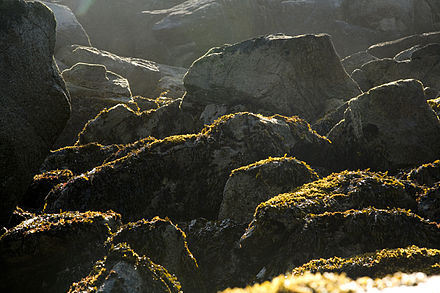Kelp
Agaraceae
Akkesiphycaceae
Alariaceae
Aureophycaceae
Chordaceae
Laminariaceae
Lessoniaceae
Pseudochordaceae
Kelps are large brown algae seaweeds that make up the order Laminariales. There are about 30 different genera.[3] Despite its appearance, kelp is not a plant since it is not made of more than one clearly differentiated tissue;[4] it is a heterokont.[5]
Kelp grows in "underwater forests" (kelp forests) in shallow oceans, and is thought to have appeared in the Miocene, 5 to 23 million years ago.[6] The organisms require nutrient-rich water with temperatures between 6 and 14 °C (43 and 57 °F). They are known for their high growth rate—the genera Macrocystis and Nereocystis can grow as fast as half a metre a day, ultimately reaching 30 to 80 metres (100 to 260 ft).[7]
Through the 19th century, the word "kelp" was closely associated with seaweeds that could be burned to obtain soda ash (primarily sodium carbonate). The seaweeds used included species from both the orders Laminariales and Fucales. The word "kelp" was also used directly to refer to these processed ashes.[8]
In most kelp, the thallus (or body) consists of flat or leaf-like structures known as blades. Blades originate from elongated stem-like structures, the stipes. The holdfast, a root-like structure, anchors the kelp to the substrate of the ocean. Gas-filled bladders (pneumatocysts) form at the base of blades of American species, such as Nereocystis lueteana, (Mert. & Post & Rupr.)[7] to hold the kelp blades close to the surface.
Growth occurs at the base of the meristem, where the blades and stipe meet. Growth may be limited by grazing. Sea urchins, for example, can reduce entire areas to urchin barrens.[9] The kelp life cycle involves a diploid sporophyte and haploid gametophyte stage. The haploid phase begins when the mature organism releases many spores, which then germinate to become male or female gametophytes. Sexual reproduction then results in the beginning of the diploid sporophyte stage, which will develop into a mature individual.


